University Report: Strategic Brand Management of Samsung Analysis
VerifiedAdded on 2023/04/21
|11
|3079
|53
Report
AI Summary
This report provides a comprehensive analysis of Samsung's strategic brand management, focusing on the four key steps: identifying and developing a brand plan, designing and implementing brand marketing programs, measuring and interpreting brand performance, and growing and sustaining brand equity. The report examines Samsung's brand equity, brand resonance model, and brand positioning, along with its brand elements, events marketing, and brand communication strategies. Furthermore, the report evaluates Samsung's product, corporate, and ingredient branding strategies using Ansoff Growth Matrix and brand extension strategy. The analysis also explores the country of origin effect on Samsung's brand and concludes with recommendations for future brand development, including modifying pricing strategies, improving product user-friendliness, and enhancing product experience. The report emphasizes the importance of adapting to market trends, maintaining high-quality standards, and leveraging technological innovation to sustain brand value and competitiveness.
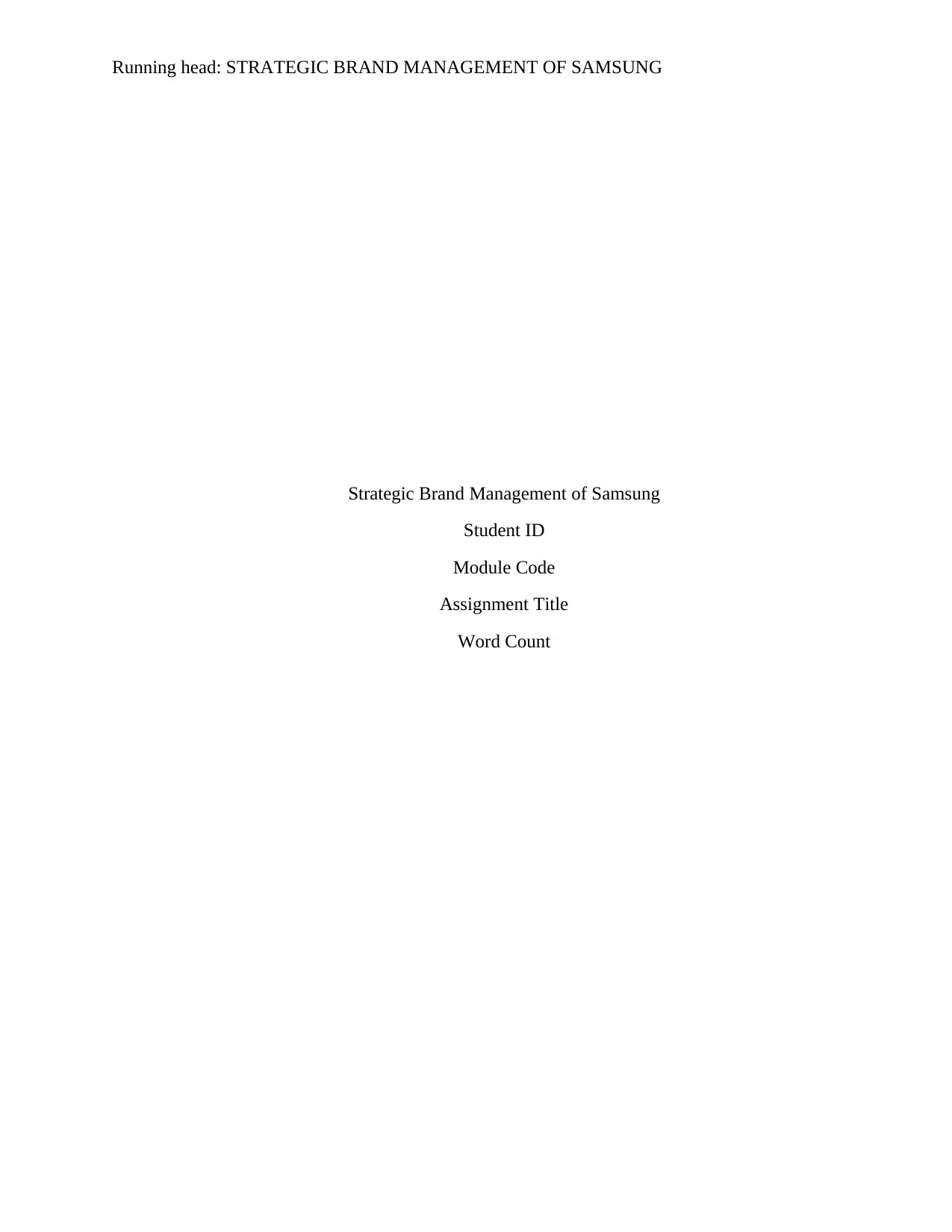
Running head: STRATEGIC BRAND MANAGEMENT OF SAMSUNG
Strategic Brand Management of Samsung
Student ID
Module Code
Assignment Title
Word Count
Strategic Brand Management of Samsung
Student ID
Module Code
Assignment Title
Word Count
Secure Best Marks with AI Grader
Need help grading? Try our AI Grader for instant feedback on your assignments.
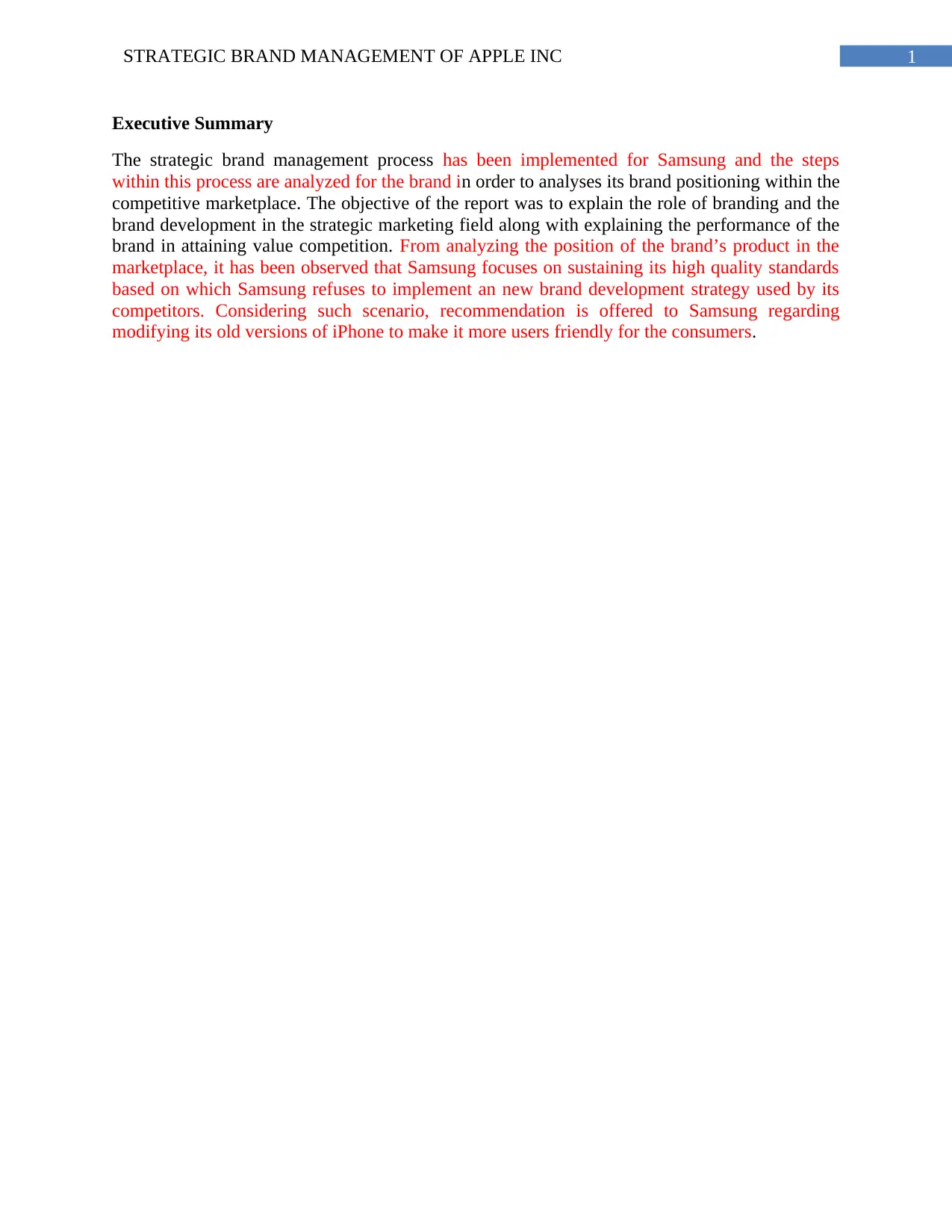
1STRATEGIC BRAND MANAGEMENT OF APPLE INC
Executive Summary
The strategic brand management process has been implemented for Samsung and the steps
within this process are analyzed for the brand in order to analyses its brand positioning within the
competitive marketplace. The objective of the report was to explain the role of branding and the
brand development in the strategic marketing field along with explaining the performance of the
brand in attaining value competition. From analyzing the position of the brand’s product in the
marketplace, it has been observed that Samsung focuses on sustaining its high quality standards
based on which Samsung refuses to implement an new brand development strategy used by its
competitors. Considering such scenario, recommendation is offered to Samsung regarding
modifying its old versions of iPhone to make it more users friendly for the consumers.
Executive Summary
The strategic brand management process has been implemented for Samsung and the steps
within this process are analyzed for the brand in order to analyses its brand positioning within the
competitive marketplace. The objective of the report was to explain the role of branding and the
brand development in the strategic marketing field along with explaining the performance of the
brand in attaining value competition. From analyzing the position of the brand’s product in the
marketplace, it has been observed that Samsung focuses on sustaining its high quality standards
based on which Samsung refuses to implement an new brand development strategy used by its
competitors. Considering such scenario, recommendation is offered to Samsung regarding
modifying its old versions of iPhone to make it more users friendly for the consumers.
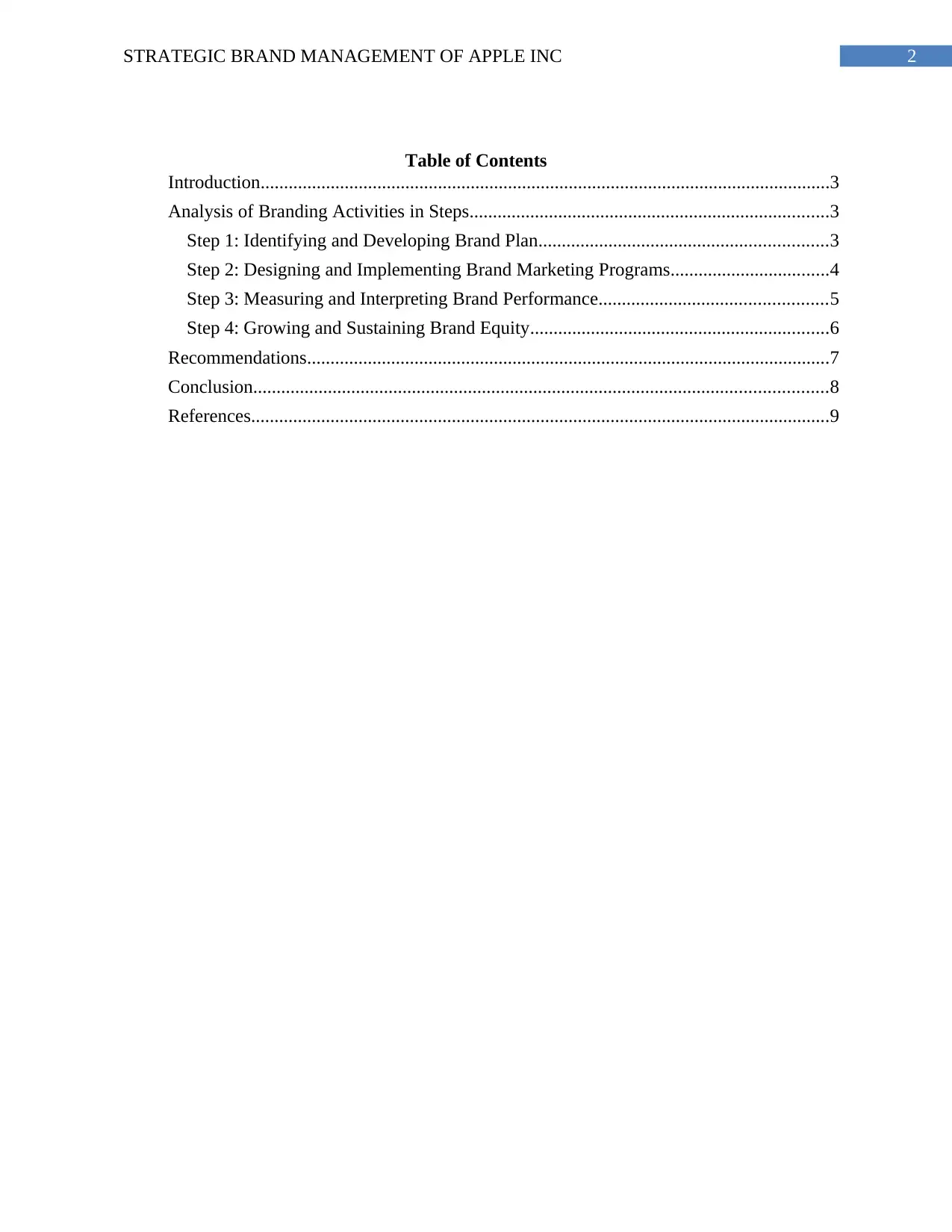
2STRATEGIC BRAND MANAGEMENT OF APPLE INC
Table of Contents
Introduction..........................................................................................................................3
Analysis of Branding Activities in Steps.............................................................................3
Step 1: Identifying and Developing Brand Plan..............................................................3
Step 2: Designing and Implementing Brand Marketing Programs..................................4
Step 3: Measuring and Interpreting Brand Performance.................................................5
Step 4: Growing and Sustaining Brand Equity................................................................6
Recommendations................................................................................................................7
Conclusion...........................................................................................................................8
References............................................................................................................................9
Table of Contents
Introduction..........................................................................................................................3
Analysis of Branding Activities in Steps.............................................................................3
Step 1: Identifying and Developing Brand Plan..............................................................3
Step 2: Designing and Implementing Brand Marketing Programs..................................4
Step 3: Measuring and Interpreting Brand Performance.................................................5
Step 4: Growing and Sustaining Brand Equity................................................................6
Recommendations................................................................................................................7
Conclusion...........................................................................................................................8
References............................................................................................................................9
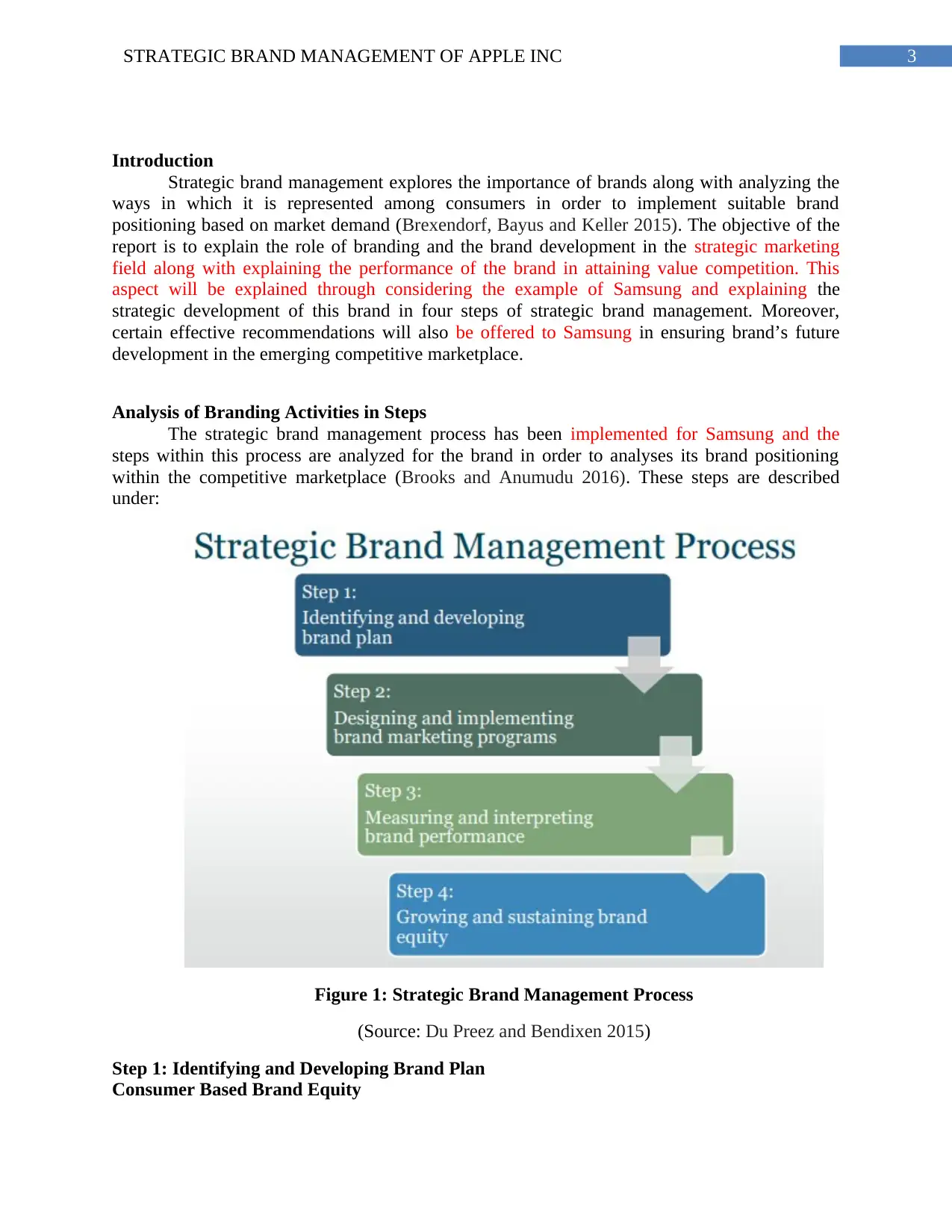
3STRATEGIC BRAND MANAGEMENT OF APPLE INC
Introduction
Strategic brand management explores the importance of brands along with analyzing the
ways in which it is represented among consumers in order to implement suitable brand
positioning based on market demand (Brexendorf, Bayus and Keller 2015). The objective of the
report is to explain the role of branding and the brand development in the strategic marketing
field along with explaining the performance of the brand in attaining value competition. This
aspect will be explained through considering the example of Samsung and explaining the
strategic development of this brand in four steps of strategic brand management. Moreover,
certain effective recommendations will also be offered to Samsung in ensuring brand’s future
development in the emerging competitive marketplace.
Analysis of Branding Activities in Steps
The strategic brand management process has been implemented for Samsung and the
steps within this process are analyzed for the brand in order to analyses its brand positioning
within the competitive marketplace (Brooks and Anumudu 2016). These steps are described
under:
Figure 1: Strategic Brand Management Process
(Source: Du Preez and Bendixen 2015)
Step 1: Identifying and Developing Brand Plan
Consumer Based Brand Equity
Introduction
Strategic brand management explores the importance of brands along with analyzing the
ways in which it is represented among consumers in order to implement suitable brand
positioning based on market demand (Brexendorf, Bayus and Keller 2015). The objective of the
report is to explain the role of branding and the brand development in the strategic marketing
field along with explaining the performance of the brand in attaining value competition. This
aspect will be explained through considering the example of Samsung and explaining the
strategic development of this brand in four steps of strategic brand management. Moreover,
certain effective recommendations will also be offered to Samsung in ensuring brand’s future
development in the emerging competitive marketplace.
Analysis of Branding Activities in Steps
The strategic brand management process has been implemented for Samsung and the
steps within this process are analyzed for the brand in order to analyses its brand positioning
within the competitive marketplace (Brooks and Anumudu 2016). These steps are described
under:
Figure 1: Strategic Brand Management Process
(Source: Du Preez and Bendixen 2015)
Step 1: Identifying and Developing Brand Plan
Consumer Based Brand Equity
Secure Best Marks with AI Grader
Need help grading? Try our AI Grader for instant feedback on your assignments.
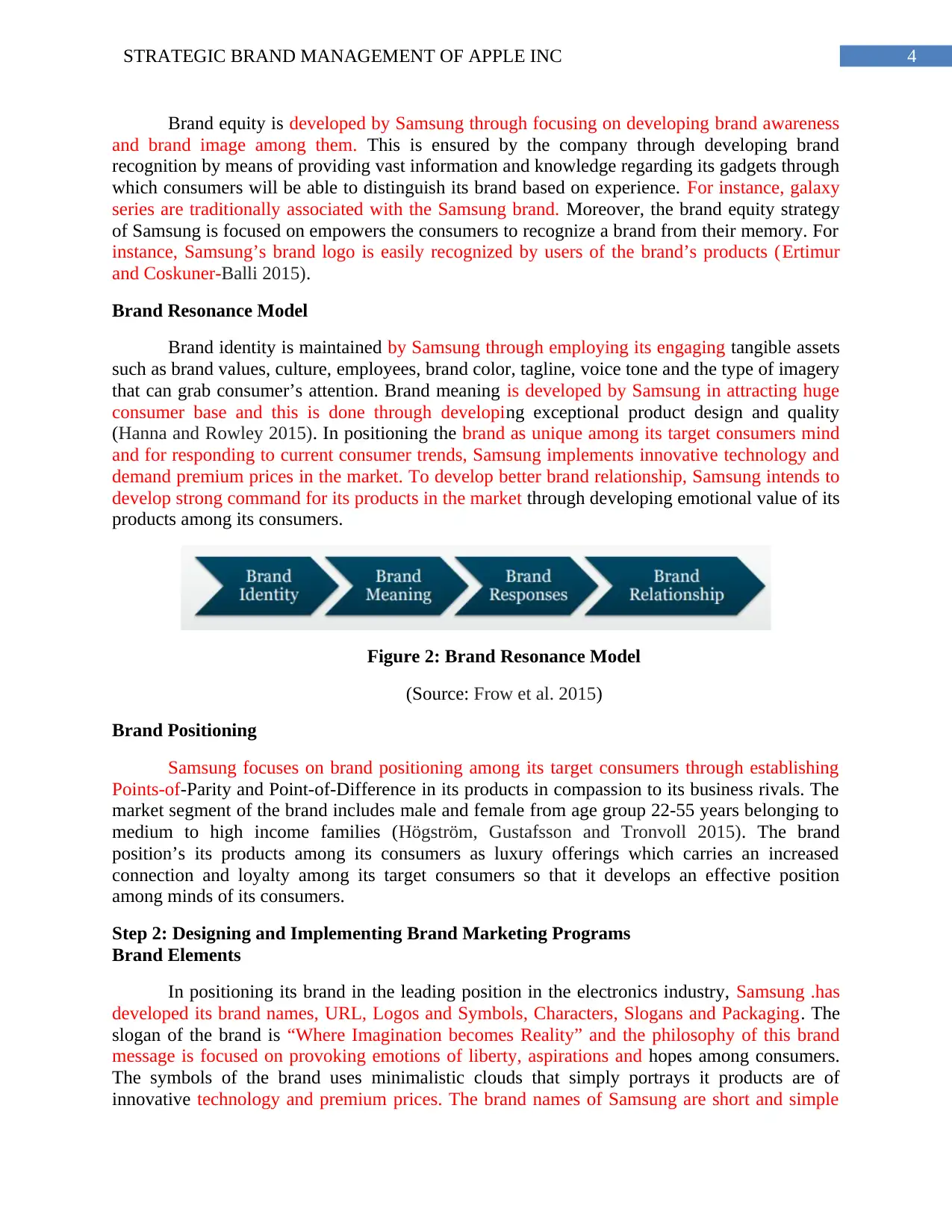
4STRATEGIC BRAND MANAGEMENT OF APPLE INC
Brand equity is developed by Samsung through focusing on developing brand awareness
and brand image among them. This is ensured by the company through developing brand
recognition by means of providing vast information and knowledge regarding its gadgets through
which consumers will be able to distinguish its brand based on experience. For instance, galaxy
series are traditionally associated with the Samsung brand. Moreover, the brand equity strategy
of Samsung is focused on empowers the consumers to recognize a brand from their memory. For
instance, Samsung’s brand logo is easily recognized by users of the brand’s products (Ertimur
and Coskuner-Balli 2015).
Brand Resonance Model
Brand identity is maintained by Samsung through employing its engaging tangible assets
such as brand values, culture, employees, brand color, tagline, voice tone and the type of imagery
that can grab consumer’s attention. Brand meaning is developed by Samsung in attracting huge
consumer base and this is done through developing exceptional product design and quality
(Hanna and Rowley 2015). In positioning the brand as unique among its target consumers mind
and for responding to current consumer trends, Samsung implements innovative technology and
demand premium prices in the market. To develop better brand relationship, Samsung intends to
develop strong command for its products in the market through developing emotional value of its
products among its consumers.
Figure 2: Brand Resonance Model
(Source: Frow et al. 2015)
Brand Positioning
Samsung focuses on brand positioning among its target consumers through establishing
Points-of-Parity and Point-of-Difference in its products in compassion to its business rivals. The
market segment of the brand includes male and female from age group 22-55 years belonging to
medium to high income families (Högström, Gustafsson and Tronvoll 2015). The brand
position’s its products among its consumers as luxury offerings which carries an increased
connection and loyalty among its target consumers so that it develops an effective position
among minds of its consumers.
Step 2: Designing and Implementing Brand Marketing Programs
Brand Elements
In positioning its brand in the leading position in the electronics industry, Samsung .has
developed its brand names, URL, Logos and Symbols, Characters, Slogans and Packaging. The
slogan of the brand is “Where Imagination becomes Reality” and the philosophy of this brand
message is focused on provoking emotions of liberty, aspirations and hopes among consumers.
The symbols of the brand uses minimalistic clouds that simply portrays it products are of
innovative technology and premium prices. The brand names of Samsung are short and simple
Brand equity is developed by Samsung through focusing on developing brand awareness
and brand image among them. This is ensured by the company through developing brand
recognition by means of providing vast information and knowledge regarding its gadgets through
which consumers will be able to distinguish its brand based on experience. For instance, galaxy
series are traditionally associated with the Samsung brand. Moreover, the brand equity strategy
of Samsung is focused on empowers the consumers to recognize a brand from their memory. For
instance, Samsung’s brand logo is easily recognized by users of the brand’s products (Ertimur
and Coskuner-Balli 2015).
Brand Resonance Model
Brand identity is maintained by Samsung through employing its engaging tangible assets
such as brand values, culture, employees, brand color, tagline, voice tone and the type of imagery
that can grab consumer’s attention. Brand meaning is developed by Samsung in attracting huge
consumer base and this is done through developing exceptional product design and quality
(Hanna and Rowley 2015). In positioning the brand as unique among its target consumers mind
and for responding to current consumer trends, Samsung implements innovative technology and
demand premium prices in the market. To develop better brand relationship, Samsung intends to
develop strong command for its products in the market through developing emotional value of its
products among its consumers.
Figure 2: Brand Resonance Model
(Source: Frow et al. 2015)
Brand Positioning
Samsung focuses on brand positioning among its target consumers through establishing
Points-of-Parity and Point-of-Difference in its products in compassion to its business rivals. The
market segment of the brand includes male and female from age group 22-55 years belonging to
medium to high income families (Högström, Gustafsson and Tronvoll 2015). The brand
position’s its products among its consumers as luxury offerings which carries an increased
connection and loyalty among its target consumers so that it develops an effective position
among minds of its consumers.
Step 2: Designing and Implementing Brand Marketing Programs
Brand Elements
In positioning its brand in the leading position in the electronics industry, Samsung .has
developed its brand names, URL, Logos and Symbols, Characters, Slogans and Packaging. The
slogan of the brand is “Where Imagination becomes Reality” and the philosophy of this brand
message is focused on provoking emotions of liberty, aspirations and hopes among consumers.
The symbols of the brand uses minimalistic clouds that simply portrays it products are of
innovative technology and premium prices. The brand names of Samsung are short and simple
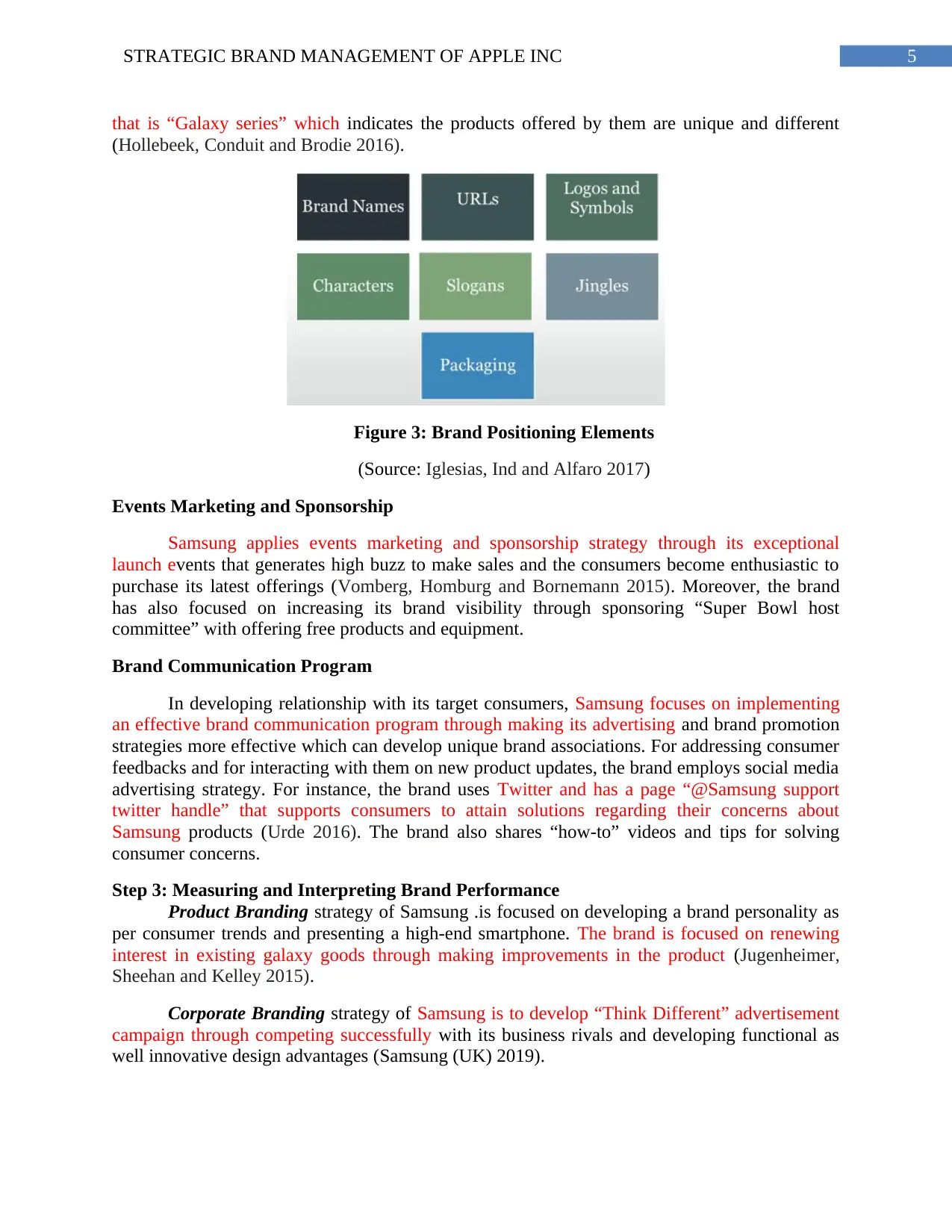
5STRATEGIC BRAND MANAGEMENT OF APPLE INC
that is “Galaxy series” which indicates the products offered by them are unique and different
(Hollebeek, Conduit and Brodie 2016).
Figure 3: Brand Positioning Elements
(Source: Iglesias, Ind and Alfaro 2017)
Events Marketing and Sponsorship
Samsung applies events marketing and sponsorship strategy through its exceptional
launch events that generates high buzz to make sales and the consumers become enthusiastic to
purchase its latest offerings (Vomberg, Homburg and Bornemann 2015). Moreover, the brand
has also focused on increasing its brand visibility through sponsoring “Super Bowl host
committee” with offering free products and equipment.
Brand Communication Program
In developing relationship with its target consumers, Samsung focuses on implementing
an effective brand communication program through making its advertising and brand promotion
strategies more effective which can develop unique brand associations. For addressing consumer
feedbacks and for interacting with them on new product updates, the brand employs social media
advertising strategy. For instance, the brand uses Twitter and has a page “@Samsung support
twitter handle” that supports consumers to attain solutions regarding their concerns about
Samsung products (Urde 2016). The brand also shares “how-to” videos and tips for solving
consumer concerns.
Step 3: Measuring and Interpreting Brand Performance
Product Branding strategy of Samsung .is focused on developing a brand personality as
per consumer trends and presenting a high-end smartphone. The brand is focused on renewing
interest in existing galaxy goods through making improvements in the product (Jugenheimer,
Sheehan and Kelley 2015).
Corporate Branding strategy of Samsung is to develop “Think Different” advertisement
campaign through competing successfully with its business rivals and developing functional as
well innovative design advantages (Samsung (UK) 2019).
that is “Galaxy series” which indicates the products offered by them are unique and different
(Hollebeek, Conduit and Brodie 2016).
Figure 3: Brand Positioning Elements
(Source: Iglesias, Ind and Alfaro 2017)
Events Marketing and Sponsorship
Samsung applies events marketing and sponsorship strategy through its exceptional
launch events that generates high buzz to make sales and the consumers become enthusiastic to
purchase its latest offerings (Vomberg, Homburg and Bornemann 2015). Moreover, the brand
has also focused on increasing its brand visibility through sponsoring “Super Bowl host
committee” with offering free products and equipment.
Brand Communication Program
In developing relationship with its target consumers, Samsung focuses on implementing
an effective brand communication program through making its advertising and brand promotion
strategies more effective which can develop unique brand associations. For addressing consumer
feedbacks and for interacting with them on new product updates, the brand employs social media
advertising strategy. For instance, the brand uses Twitter and has a page “@Samsung support
twitter handle” that supports consumers to attain solutions regarding their concerns about
Samsung products (Urde 2016). The brand also shares “how-to” videos and tips for solving
consumer concerns.
Step 3: Measuring and Interpreting Brand Performance
Product Branding strategy of Samsung .is focused on developing a brand personality as
per consumer trends and presenting a high-end smartphone. The brand is focused on renewing
interest in existing galaxy goods through making improvements in the product (Jugenheimer,
Sheehan and Kelley 2015).
Corporate Branding strategy of Samsung is to develop “Think Different” advertisement
campaign through competing successfully with its business rivals and developing functional as
well innovative design advantages (Samsung (UK) 2019).
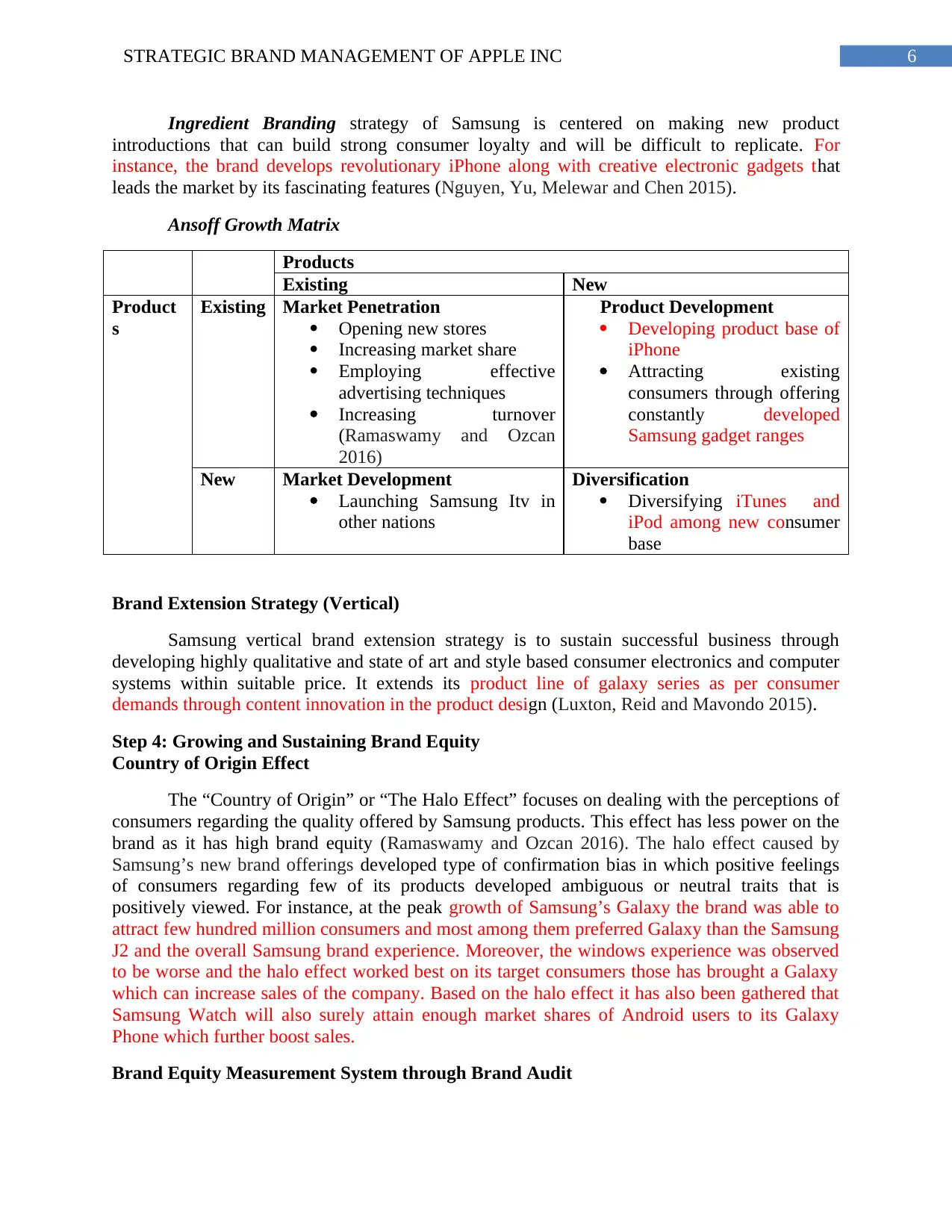
6STRATEGIC BRAND MANAGEMENT OF APPLE INC
Ingredient Branding strategy of Samsung is centered on making new product
introductions that can build strong consumer loyalty and will be difficult to replicate. For
instance, the brand develops revolutionary iPhone along with creative electronic gadgets that
leads the market by its fascinating features (Nguyen, Yu, Melewar and Chen 2015).
Ansoff Growth Matrix
Products
Existing New
Product
s
Existing Market Penetration
Opening new stores
Increasing market share
Employing effective
advertising techniques
Increasing turnover
(Ramaswamy and Ozcan
2016)
Product Development
Developing product base of
iPhone
Attracting existing
consumers through offering
constantly developed
Samsung gadget ranges
New Market Development
Launching Samsung Itv in
other nations
Diversification
Diversifying iTunes and
iPod among new consumer
base
Brand Extension Strategy (Vertical)
Samsung vertical brand extension strategy is to sustain successful business through
developing highly qualitative and state of art and style based consumer electronics and computer
systems within suitable price. It extends its product line of galaxy series as per consumer
demands through content innovation in the product design (Luxton, Reid and Mavondo 2015).
Step 4: Growing and Sustaining Brand Equity
Country of Origin Effect
The “Country of Origin” or “The Halo Effect” focuses on dealing with the perceptions of
consumers regarding the quality offered by Samsung products. This effect has less power on the
brand as it has high brand equity (Ramaswamy and Ozcan 2016). The halo effect caused by
Samsung’s new brand offerings developed type of confirmation bias in which positive feelings
of consumers regarding few of its products developed ambiguous or neutral traits that is
positively viewed. For instance, at the peak growth of Samsung’s Galaxy the brand was able to
attract few hundred million consumers and most among them preferred Galaxy than the Samsung
J2 and the overall Samsung brand experience. Moreover, the windows experience was observed
to be worse and the halo effect worked best on its target consumers those has brought a Galaxy
which can increase sales of the company. Based on the halo effect it has also been gathered that
Samsung Watch will also surely attain enough market shares of Android users to its Galaxy
Phone which further boost sales.
Brand Equity Measurement System through Brand Audit
Ingredient Branding strategy of Samsung is centered on making new product
introductions that can build strong consumer loyalty and will be difficult to replicate. For
instance, the brand develops revolutionary iPhone along with creative electronic gadgets that
leads the market by its fascinating features (Nguyen, Yu, Melewar and Chen 2015).
Ansoff Growth Matrix
Products
Existing New
Product
s
Existing Market Penetration
Opening new stores
Increasing market share
Employing effective
advertising techniques
Increasing turnover
(Ramaswamy and Ozcan
2016)
Product Development
Developing product base of
iPhone
Attracting existing
consumers through offering
constantly developed
Samsung gadget ranges
New Market Development
Launching Samsung Itv in
other nations
Diversification
Diversifying iTunes and
iPod among new consumer
base
Brand Extension Strategy (Vertical)
Samsung vertical brand extension strategy is to sustain successful business through
developing highly qualitative and state of art and style based consumer electronics and computer
systems within suitable price. It extends its product line of galaxy series as per consumer
demands through content innovation in the product design (Luxton, Reid and Mavondo 2015).
Step 4: Growing and Sustaining Brand Equity
Country of Origin Effect
The “Country of Origin” or “The Halo Effect” focuses on dealing with the perceptions of
consumers regarding the quality offered by Samsung products. This effect has less power on the
brand as it has high brand equity (Ramaswamy and Ozcan 2016). The halo effect caused by
Samsung’s new brand offerings developed type of confirmation bias in which positive feelings
of consumers regarding few of its products developed ambiguous or neutral traits that is
positively viewed. For instance, at the peak growth of Samsung’s Galaxy the brand was able to
attract few hundred million consumers and most among them preferred Galaxy than the Samsung
J2 and the overall Samsung brand experience. Moreover, the windows experience was observed
to be worse and the halo effect worked best on its target consumers those has brought a Galaxy
which can increase sales of the company. Based on the halo effect it has also been gathered that
Samsung Watch will also surely attain enough market shares of Android users to its Galaxy
Phone which further boost sales.
Brand Equity Measurement System through Brand Audit
Paraphrase This Document
Need a fresh take? Get an instant paraphrase of this document with our AI Paraphraser
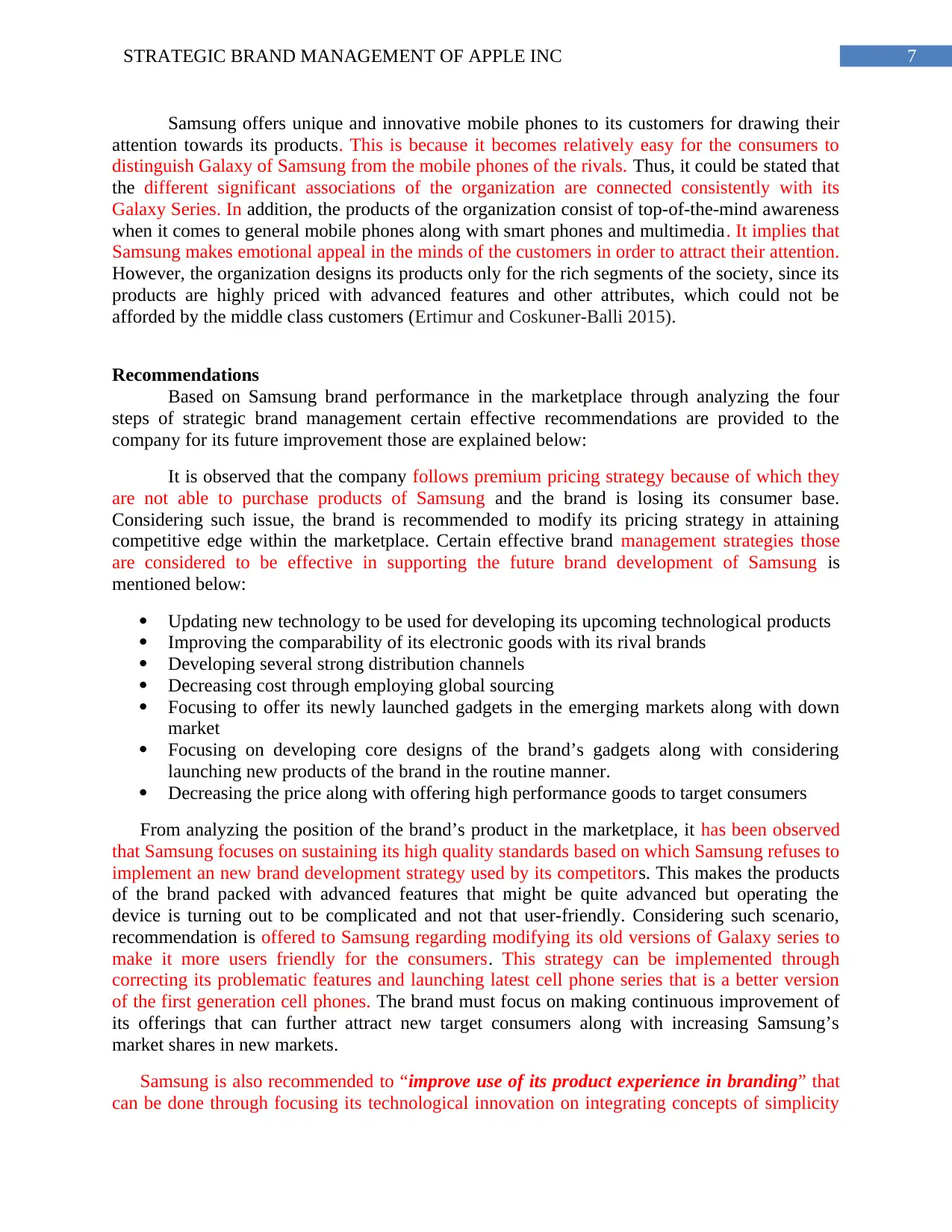
7STRATEGIC BRAND MANAGEMENT OF APPLE INC
Samsung offers unique and innovative mobile phones to its customers for drawing their
attention towards its products. This is because it becomes relatively easy for the consumers to
distinguish Galaxy of Samsung from the mobile phones of the rivals. Thus, it could be stated that
the different significant associations of the organization are connected consistently with its
Galaxy Series. In addition, the products of the organization consist of top-of-the-mind awareness
when it comes to general mobile phones along with smart phones and multimedia. It implies that
Samsung makes emotional appeal in the minds of the customers in order to attract their attention.
However, the organization designs its products only for the rich segments of the society, since its
products are highly priced with advanced features and other attributes, which could not be
afforded by the middle class customers (Ertimur and Coskuner-Balli 2015).
Recommendations
Based on Samsung brand performance in the marketplace through analyzing the four
steps of strategic brand management certain effective recommendations are provided to the
company for its future improvement those are explained below:
It is observed that the company follows premium pricing strategy because of which they
are not able to purchase products of Samsung and the brand is losing its consumer base.
Considering such issue, the brand is recommended to modify its pricing strategy in attaining
competitive edge within the marketplace. Certain effective brand management strategies those
are considered to be effective in supporting the future brand development of Samsung is
mentioned below:
Updating new technology to be used for developing its upcoming technological products
Improving the comparability of its electronic goods with its rival brands
Developing several strong distribution channels
Decreasing cost through employing global sourcing
Focusing to offer its newly launched gadgets in the emerging markets along with down
market
Focusing on developing core designs of the brand’s gadgets along with considering
launching new products of the brand in the routine manner.
Decreasing the price along with offering high performance goods to target consumers
From analyzing the position of the brand’s product in the marketplace, it has been observed
that Samsung focuses on sustaining its high quality standards based on which Samsung refuses to
implement an new brand development strategy used by its competitors. This makes the products
of the brand packed with advanced features that might be quite advanced but operating the
device is turning out to be complicated and not that user-friendly. Considering such scenario,
recommendation is offered to Samsung regarding modifying its old versions of Galaxy series to
make it more users friendly for the consumers. This strategy can be implemented through
correcting its problematic features and launching latest cell phone series that is a better version
of the first generation cell phones. The brand must focus on making continuous improvement of
its offerings that can further attract new target consumers along with increasing Samsung’s
market shares in new markets.
Samsung is also recommended to “improve use of its product experience in branding” that
can be done through focusing its technological innovation on integrating concepts of simplicity
Samsung offers unique and innovative mobile phones to its customers for drawing their
attention towards its products. This is because it becomes relatively easy for the consumers to
distinguish Galaxy of Samsung from the mobile phones of the rivals. Thus, it could be stated that
the different significant associations of the organization are connected consistently with its
Galaxy Series. In addition, the products of the organization consist of top-of-the-mind awareness
when it comes to general mobile phones along with smart phones and multimedia. It implies that
Samsung makes emotional appeal in the minds of the customers in order to attract their attention.
However, the organization designs its products only for the rich segments of the society, since its
products are highly priced with advanced features and other attributes, which could not be
afforded by the middle class customers (Ertimur and Coskuner-Balli 2015).
Recommendations
Based on Samsung brand performance in the marketplace through analyzing the four
steps of strategic brand management certain effective recommendations are provided to the
company for its future improvement those are explained below:
It is observed that the company follows premium pricing strategy because of which they
are not able to purchase products of Samsung and the brand is losing its consumer base.
Considering such issue, the brand is recommended to modify its pricing strategy in attaining
competitive edge within the marketplace. Certain effective brand management strategies those
are considered to be effective in supporting the future brand development of Samsung is
mentioned below:
Updating new technology to be used for developing its upcoming technological products
Improving the comparability of its electronic goods with its rival brands
Developing several strong distribution channels
Decreasing cost through employing global sourcing
Focusing to offer its newly launched gadgets in the emerging markets along with down
market
Focusing on developing core designs of the brand’s gadgets along with considering
launching new products of the brand in the routine manner.
Decreasing the price along with offering high performance goods to target consumers
From analyzing the position of the brand’s product in the marketplace, it has been observed
that Samsung focuses on sustaining its high quality standards based on which Samsung refuses to
implement an new brand development strategy used by its competitors. This makes the products
of the brand packed with advanced features that might be quite advanced but operating the
device is turning out to be complicated and not that user-friendly. Considering such scenario,
recommendation is offered to Samsung regarding modifying its old versions of Galaxy series to
make it more users friendly for the consumers. This strategy can be implemented through
correcting its problematic features and launching latest cell phone series that is a better version
of the first generation cell phones. The brand must focus on making continuous improvement of
its offerings that can further attract new target consumers along with increasing Samsung’s
market shares in new markets.
Samsung is also recommended to “improve use of its product experience in branding” that
can be done through focusing its technological innovation on integrating concepts of simplicity
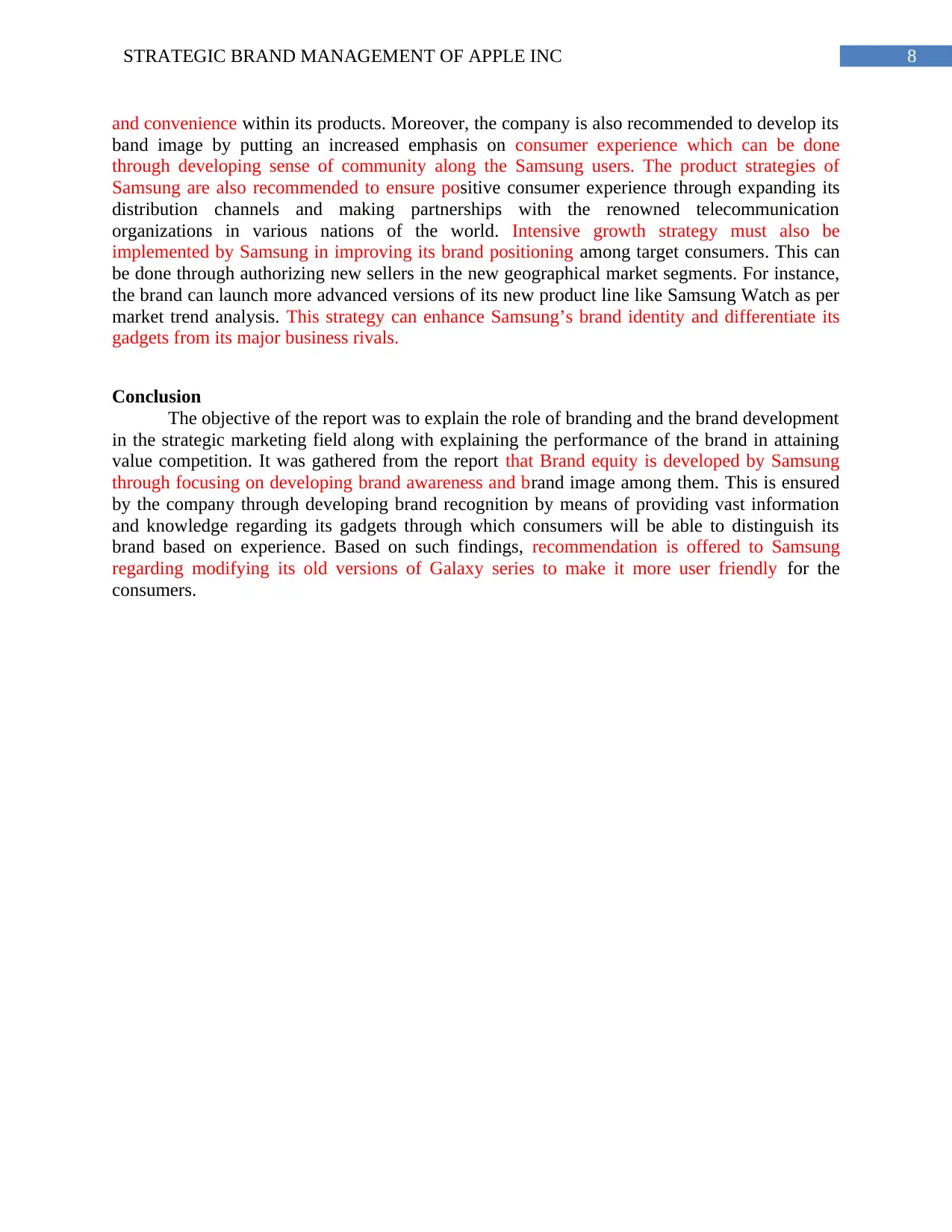
8STRATEGIC BRAND MANAGEMENT OF APPLE INC
and convenience within its products. Moreover, the company is also recommended to develop its
band image by putting an increased emphasis on consumer experience which can be done
through developing sense of community along the Samsung users. The product strategies of
Samsung are also recommended to ensure positive consumer experience through expanding its
distribution channels and making partnerships with the renowned telecommunication
organizations in various nations of the world. Intensive growth strategy must also be
implemented by Samsung in improving its brand positioning among target consumers. This can
be done through authorizing new sellers in the new geographical market segments. For instance,
the brand can launch more advanced versions of its new product line like Samsung Watch as per
market trend analysis. This strategy can enhance Samsung’s brand identity and differentiate its
gadgets from its major business rivals.
Conclusion
The objective of the report was to explain the role of branding and the brand development
in the strategic marketing field along with explaining the performance of the brand in attaining
value competition. It was gathered from the report that Brand equity is developed by Samsung
through focusing on developing brand awareness and brand image among them. This is ensured
by the company through developing brand recognition by means of providing vast information
and knowledge regarding its gadgets through which consumers will be able to distinguish its
brand based on experience. Based on such findings, recommendation is offered to Samsung
regarding modifying its old versions of Galaxy series to make it more user friendly for the
consumers.
and convenience within its products. Moreover, the company is also recommended to develop its
band image by putting an increased emphasis on consumer experience which can be done
through developing sense of community along the Samsung users. The product strategies of
Samsung are also recommended to ensure positive consumer experience through expanding its
distribution channels and making partnerships with the renowned telecommunication
organizations in various nations of the world. Intensive growth strategy must also be
implemented by Samsung in improving its brand positioning among target consumers. This can
be done through authorizing new sellers in the new geographical market segments. For instance,
the brand can launch more advanced versions of its new product line like Samsung Watch as per
market trend analysis. This strategy can enhance Samsung’s brand identity and differentiate its
gadgets from its major business rivals.
Conclusion
The objective of the report was to explain the role of branding and the brand development
in the strategic marketing field along with explaining the performance of the brand in attaining
value competition. It was gathered from the report that Brand equity is developed by Samsung
through focusing on developing brand awareness and brand image among them. This is ensured
by the company through developing brand recognition by means of providing vast information
and knowledge regarding its gadgets through which consumers will be able to distinguish its
brand based on experience. Based on such findings, recommendation is offered to Samsung
regarding modifying its old versions of Galaxy series to make it more user friendly for the
consumers.
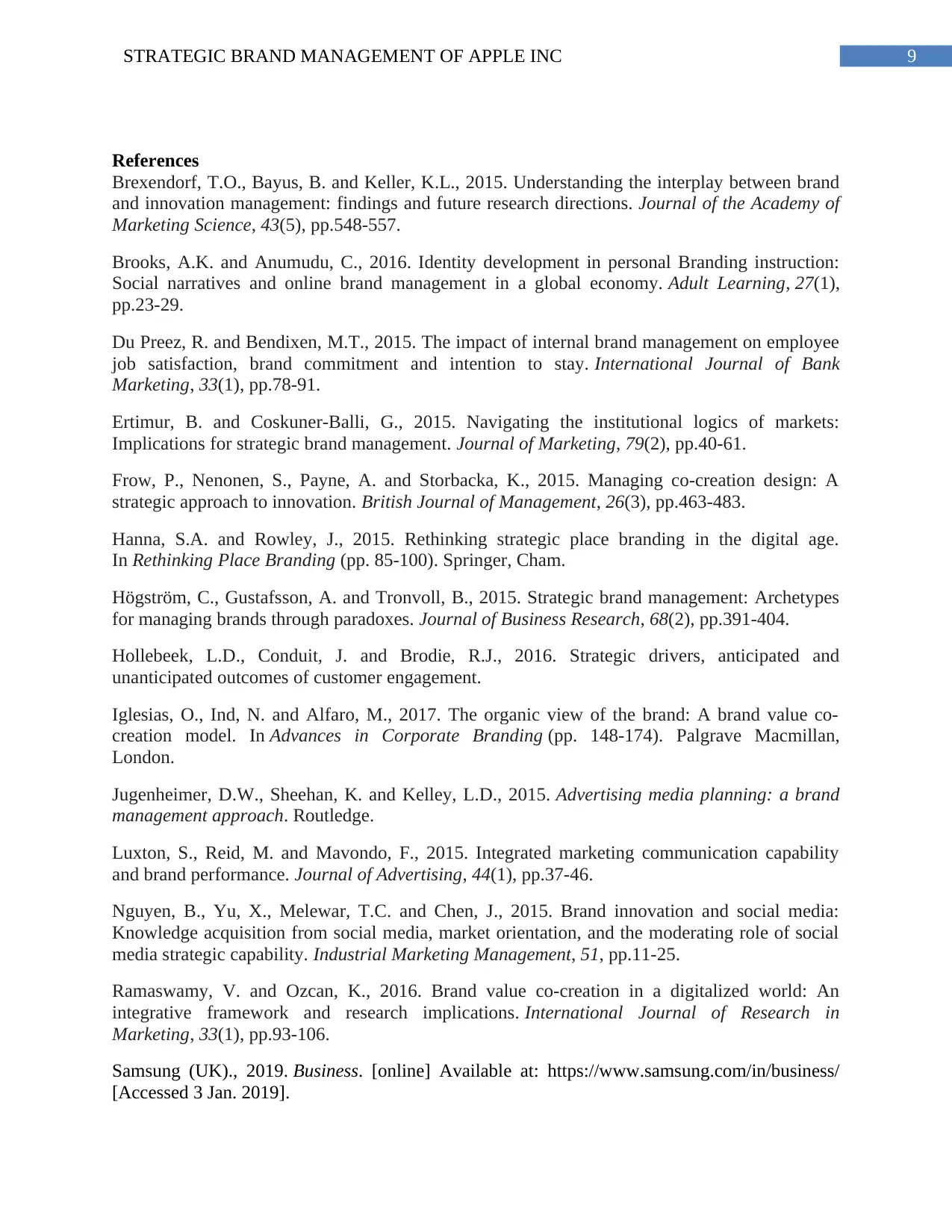
9STRATEGIC BRAND MANAGEMENT OF APPLE INC
References
Brexendorf, T.O., Bayus, B. and Keller, K.L., 2015. Understanding the interplay between brand
and innovation management: findings and future research directions. Journal of the Academy of
Marketing Science, 43(5), pp.548-557.
Brooks, A.K. and Anumudu, C., 2016. Identity development in personal Branding instruction:
Social narratives and online brand management in a global economy. Adult Learning, 27(1),
pp.23-29.
Du Preez, R. and Bendixen, M.T., 2015. The impact of internal brand management on employee
job satisfaction, brand commitment and intention to stay. International Journal of Bank
Marketing, 33(1), pp.78-91.
Ertimur, B. and Coskuner-Balli, G., 2015. Navigating the institutional logics of markets:
Implications for strategic brand management. Journal of Marketing, 79(2), pp.40-61.
Frow, P., Nenonen, S., Payne, A. and Storbacka, K., 2015. Managing co‐creation design: A
strategic approach to innovation. British Journal of Management, 26(3), pp.463-483.
Hanna, S.A. and Rowley, J., 2015. Rethinking strategic place branding in the digital age.
In Rethinking Place Branding (pp. 85-100). Springer, Cham.
Högström, C., Gustafsson, A. and Tronvoll, B., 2015. Strategic brand management: Archetypes
for managing brands through paradoxes. Journal of Business Research, 68(2), pp.391-404.
Hollebeek, L.D., Conduit, J. and Brodie, R.J., 2016. Strategic drivers, anticipated and
unanticipated outcomes of customer engagement.
Iglesias, O., Ind, N. and Alfaro, M., 2017. The organic view of the brand: A brand value co-
creation model. In Advances in Corporate Branding (pp. 148-174). Palgrave Macmillan,
London.
Jugenheimer, D.W., Sheehan, K. and Kelley, L.D., 2015. Advertising media planning: a brand
management approach. Routledge.
Luxton, S., Reid, M. and Mavondo, F., 2015. Integrated marketing communication capability
and brand performance. Journal of Advertising, 44(1), pp.37-46.
Nguyen, B., Yu, X., Melewar, T.C. and Chen, J., 2015. Brand innovation and social media:
Knowledge acquisition from social media, market orientation, and the moderating role of social
media strategic capability. Industrial Marketing Management, 51, pp.11-25.
Ramaswamy, V. and Ozcan, K., 2016. Brand value co-creation in a digitalized world: An
integrative framework and research implications. International Journal of Research in
Marketing, 33(1), pp.93-106.
Samsung (UK)., 2019. Business. [online] Available at: https://www.samsung.com/in/business/
[Accessed 3 Jan. 2019].
References
Brexendorf, T.O., Bayus, B. and Keller, K.L., 2015. Understanding the interplay between brand
and innovation management: findings and future research directions. Journal of the Academy of
Marketing Science, 43(5), pp.548-557.
Brooks, A.K. and Anumudu, C., 2016. Identity development in personal Branding instruction:
Social narratives and online brand management in a global economy. Adult Learning, 27(1),
pp.23-29.
Du Preez, R. and Bendixen, M.T., 2015. The impact of internal brand management on employee
job satisfaction, brand commitment and intention to stay. International Journal of Bank
Marketing, 33(1), pp.78-91.
Ertimur, B. and Coskuner-Balli, G., 2015. Navigating the institutional logics of markets:
Implications for strategic brand management. Journal of Marketing, 79(2), pp.40-61.
Frow, P., Nenonen, S., Payne, A. and Storbacka, K., 2015. Managing co‐creation design: A
strategic approach to innovation. British Journal of Management, 26(3), pp.463-483.
Hanna, S.A. and Rowley, J., 2015. Rethinking strategic place branding in the digital age.
In Rethinking Place Branding (pp. 85-100). Springer, Cham.
Högström, C., Gustafsson, A. and Tronvoll, B., 2015. Strategic brand management: Archetypes
for managing brands through paradoxes. Journal of Business Research, 68(2), pp.391-404.
Hollebeek, L.D., Conduit, J. and Brodie, R.J., 2016. Strategic drivers, anticipated and
unanticipated outcomes of customer engagement.
Iglesias, O., Ind, N. and Alfaro, M., 2017. The organic view of the brand: A brand value co-
creation model. In Advances in Corporate Branding (pp. 148-174). Palgrave Macmillan,
London.
Jugenheimer, D.W., Sheehan, K. and Kelley, L.D., 2015. Advertising media planning: a brand
management approach. Routledge.
Luxton, S., Reid, M. and Mavondo, F., 2015. Integrated marketing communication capability
and brand performance. Journal of Advertising, 44(1), pp.37-46.
Nguyen, B., Yu, X., Melewar, T.C. and Chen, J., 2015. Brand innovation and social media:
Knowledge acquisition from social media, market orientation, and the moderating role of social
media strategic capability. Industrial Marketing Management, 51, pp.11-25.
Ramaswamy, V. and Ozcan, K., 2016. Brand value co-creation in a digitalized world: An
integrative framework and research implications. International Journal of Research in
Marketing, 33(1), pp.93-106.
Samsung (UK)., 2019. Business. [online] Available at: https://www.samsung.com/in/business/
[Accessed 3 Jan. 2019].
Secure Best Marks with AI Grader
Need help grading? Try our AI Grader for instant feedback on your assignments.

10STRATEGIC BRAND MANAGEMENT OF APPLE INC
Urde, M., 2016. The brand core and its management over time. Journal of product & brand
management, 25(1), pp.26-42.
Vomberg, A., Homburg, C. and Bornemann, T., 2015. Talented people and strong brands: The
contribution of human capital and brand equity to firm value. Strategic Management
Journal, 36(13), pp.2122-2131.
Urde, M., 2016. The brand core and its management over time. Journal of product & brand
management, 25(1), pp.26-42.
Vomberg, A., Homburg, C. and Bornemann, T., 2015. Talented people and strong brands: The
contribution of human capital and brand equity to firm value. Strategic Management
Journal, 36(13), pp.2122-2131.
1 out of 11
Related Documents
Your All-in-One AI-Powered Toolkit for Academic Success.
+13062052269
info@desklib.com
Available 24*7 on WhatsApp / Email
![[object Object]](/_next/static/media/star-bottom.7253800d.svg)
Unlock your academic potential
© 2024 | Zucol Services PVT LTD | All rights reserved.





